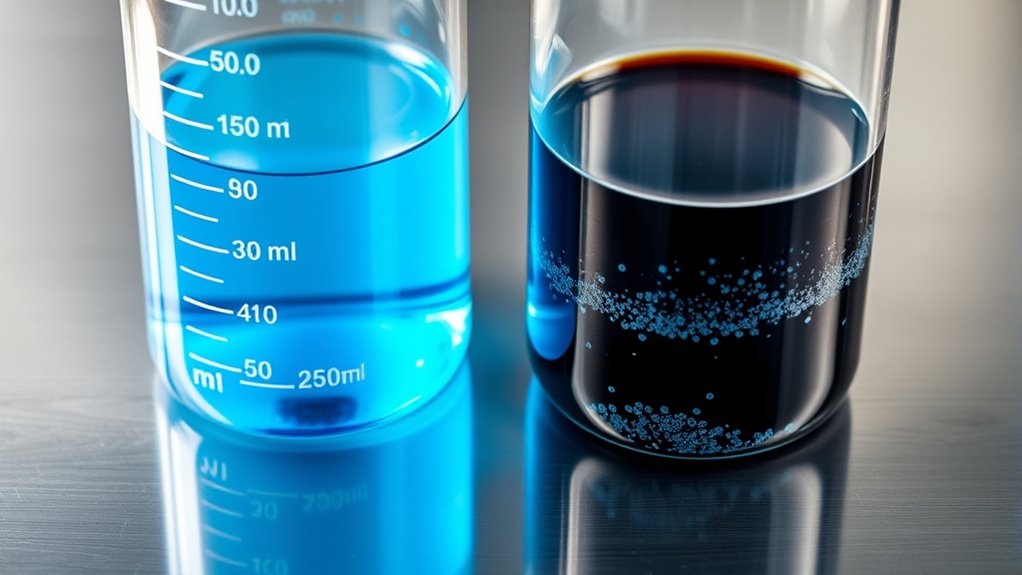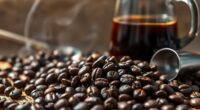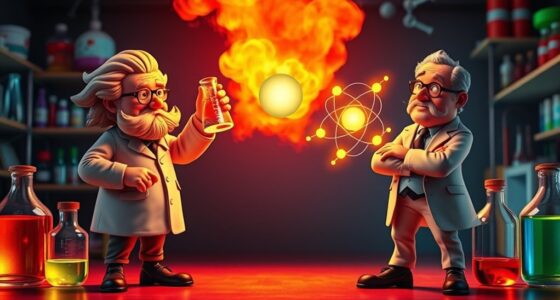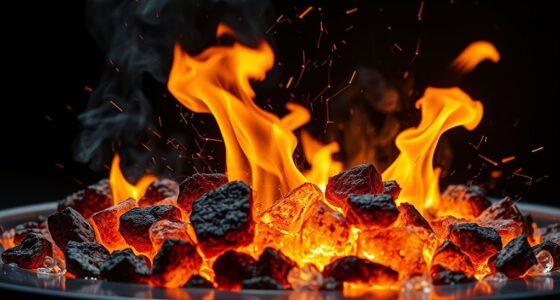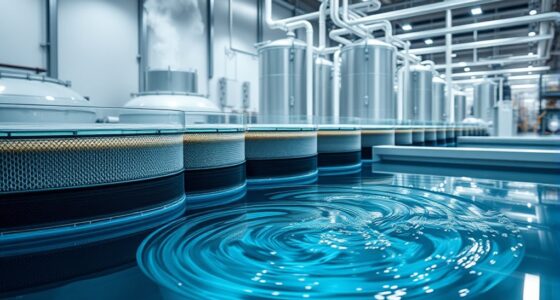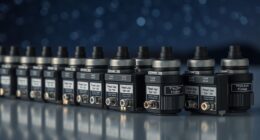Molarity and molality both measure solution concentration but differ in how they do so. Molarity is based on moles of solute divided by total solution volume, so it can change with temperature or pressure. Molality uses moles of solute per kilogram of solvent, making it unaffected by these factors. Understanding these differences helps you choose the right method for your experiments. Keep going to discover more details about when and why to use each approach.
Key Takeaways
- Molarity (mol/L) measures solute concentration based on total solution volume, while molality (mol/kg) depends solely on solvent mass.
- Molarity varies with temperature and pressure due to volume changes; molality remains constant regardless of environmental conditions.
- Molarity is commonly used in laboratory procedures like titrations; molality is preferred for high-temperature or high-pressure systems.
- To calculate molarity, divide moles of solute by total solution volume; for molality, divide moles of solute by solvent mass.
- Solvent density affects molarity but not molality, making molality more stable in environments with density fluctuations.
Defining Molarity and Molality
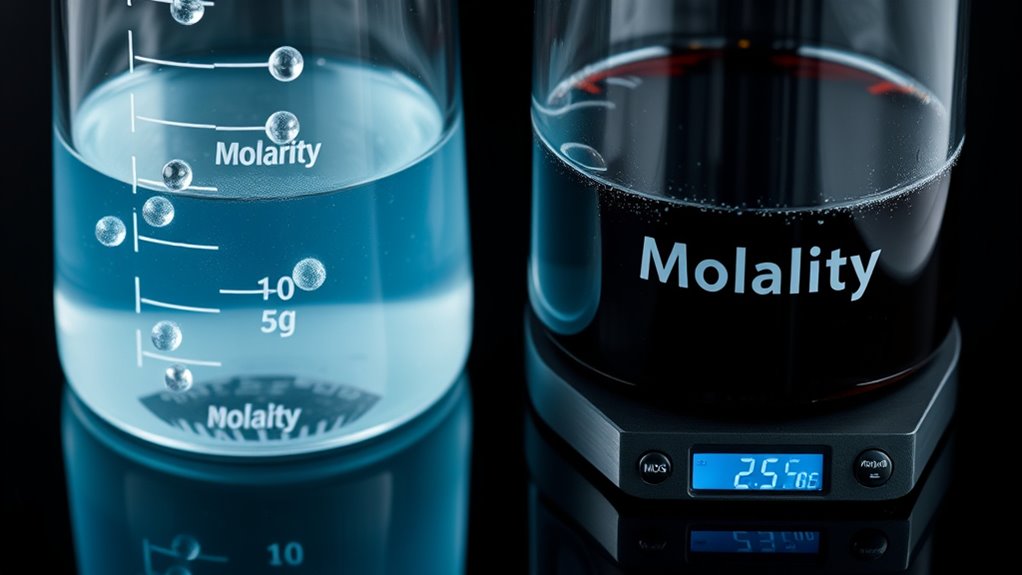
Have you ever wondered how scientists measure the concentration of a solution? Molarity, or molar concentration, is the number of moles of solute dissolved in one liter of total solution. It tells you how concentrated the solution is based on the entire mixture’s volume. Molarity is widely used in laboratory settings because it simplifies calculations involving solutions. The symbol for molarity is M, with units of mol/L. In contrast, molality measures how many moles of solute are present per kilogram of solvent only, not including the solute. It uses the solvent’s mass and is symbolized as m, with units mol/kg.
Unlike molarity, molality remains constant regardless of temperature changes because it depends solely on mass, which doesn’t vary with temperature. Both measures quantify concentration but serve different purposes depending on your needs.
How to Calculate Molarity and Molality

To calculate molarity and molality accurately, you need to follow specific steps for each measurement. For molarity, first find the moles of solute by dividing its mass by molar mass. Measure the total solution volume in liters, making certain you convert from milliliters if necessary. Use the formula ( M = frac{n}{V} ) to find molarity, ensuring your volume measurement is precise. Molarity measures the number of moles of solute per liter of solution, providing a clear indication of concentration. For molality, calculate moles of solute as before, but measure the solvent’s mass in kilograms separately, without including the solute. Divide the moles by the solvent’s mass to get molality. Additionally, understanding the difference between molarity and molality helps in selecting the appropriate measurement for specific laboratory conditions.
Key Differences in Units and Measurement
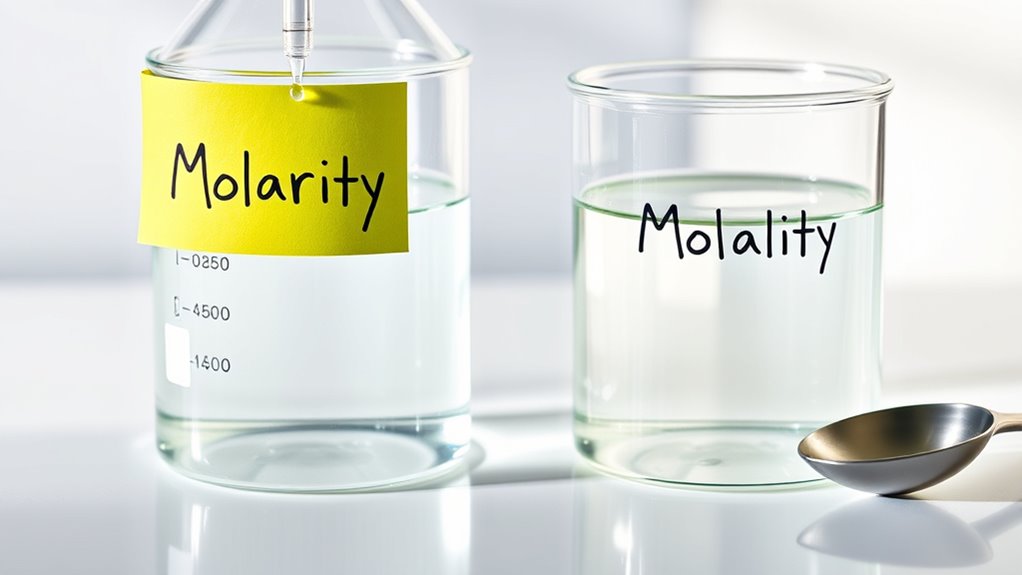
Understanding the key differences in units and measurement between molarity and molality is essential for accurate solution preparation and analysis.
Molarity measures the concentration based on moles of solute per liter of solution, so it depends on the total volume, which can change with temperature or pressure.
In contrast, molality uses moles of solute per kilogram of solvent, unaffected by volume fluctuations.
Molarity is expressed in mol/L, while molality uses mol/kg.
Molarity is more practical for laboratory work since volume measurements are straightforward, but molality offers greater accuracy because it relies solely on mass, which remains constant regardless of environmental conditions.
Additionally, solvent properties can influence the choice between molarity and molality depending on the precision required for the experiment.
Recognizing these differences helps you choose the right method for precise chemical analysis.
Practical Situations for Using Each Method
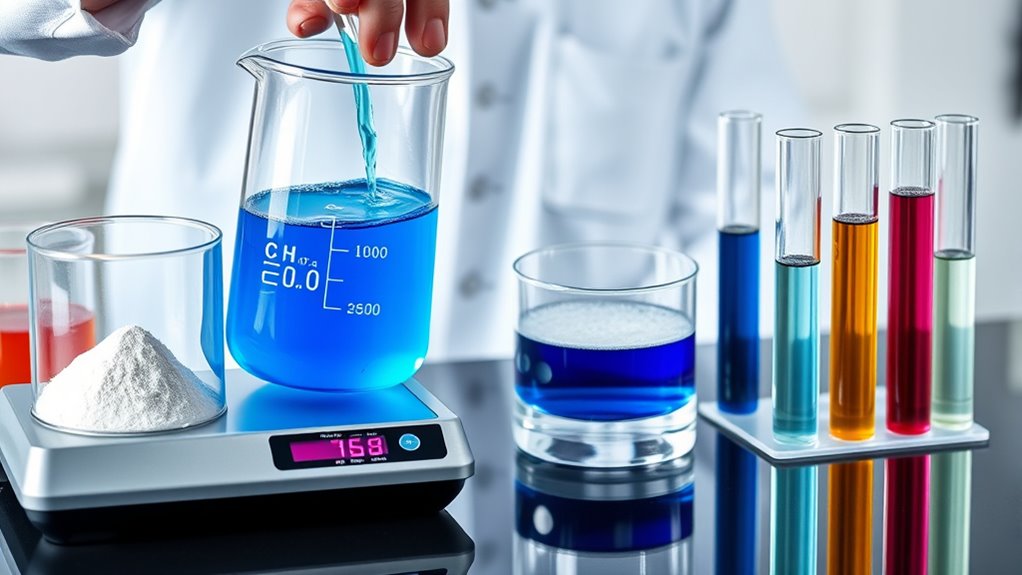
Choosing the right method for measuring solution concentration depends on the specific conditions of your experiment or application.
Selecting the appropriate concentration measurement method depends on your experiment’s specific conditions and requirements.
If you’re working in chemical synthesis, molarity helps you determine exact reactant amounts, while titrations rely on molarity for precise calculations of unknown solutions.
In pharmaceutical preparations, molarity ensures accurate drug dosages, and in the food industry, it controls preservative and additive concentrations.
For agricultural applications, molarity aids in calculating fertilizer concentrations.
Conversely, molality suits high-pressure or high-temperature environments where solution volume fluctuates, such as in geological studies or cryogenic processes.
It’s also ideal for concentrated solutions and non-aqueous systems, where solvent density impacts measurements.
Additionally, fabric decorating markers can be used to customize solutions for educational demonstrations, making complex concepts more accessible.
Knowing these practical scenarios helps you select the most appropriate method for accurate, reliable results in diverse fields.
The Impact of Solvent Density on Concentration Measurements
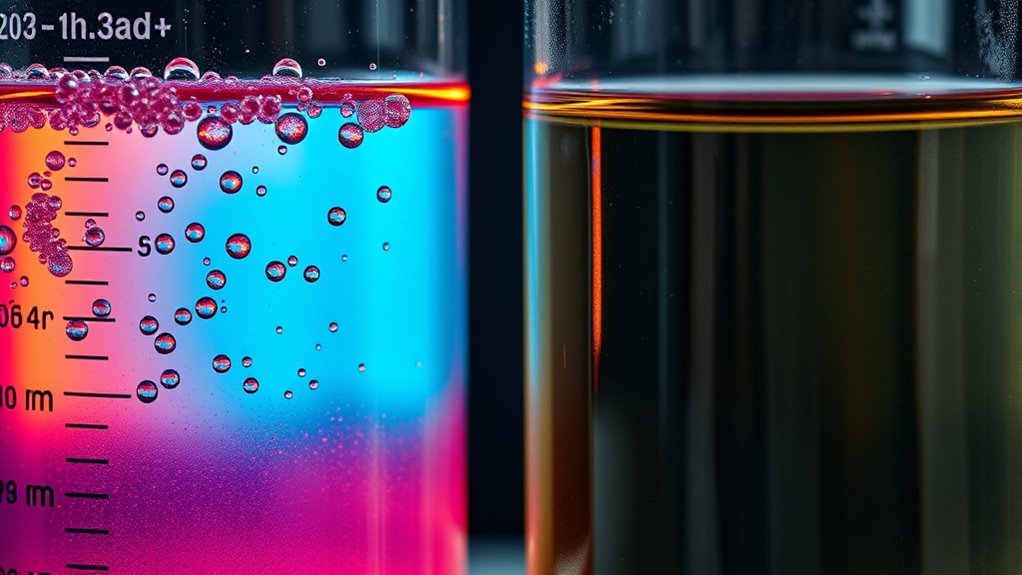
Solvent density plays a crucial role in how you measure solution concentration, especially when using molarity. Since molarity is based on liters of solution, fluctuations in solvent density directly influence volume measurements.
When temperature or pressure change, density shifts, causing the solution’s volume to expand or contract, which impacts the calculated molarity. An increase in solute concentration raises the solution’s density, reducing volume and potentially skewing results if not properly controlled.
These density variations make molarity less reliable in systems with mixed solvents or temperature fluctuations. In contrast, molality depends on the solvent’s mass, unaffected by volume changes.
Thus, in environments with varying density, molality offers a more stable and accurate measure of concentration.
Choosing the Right Method for Accurate Results
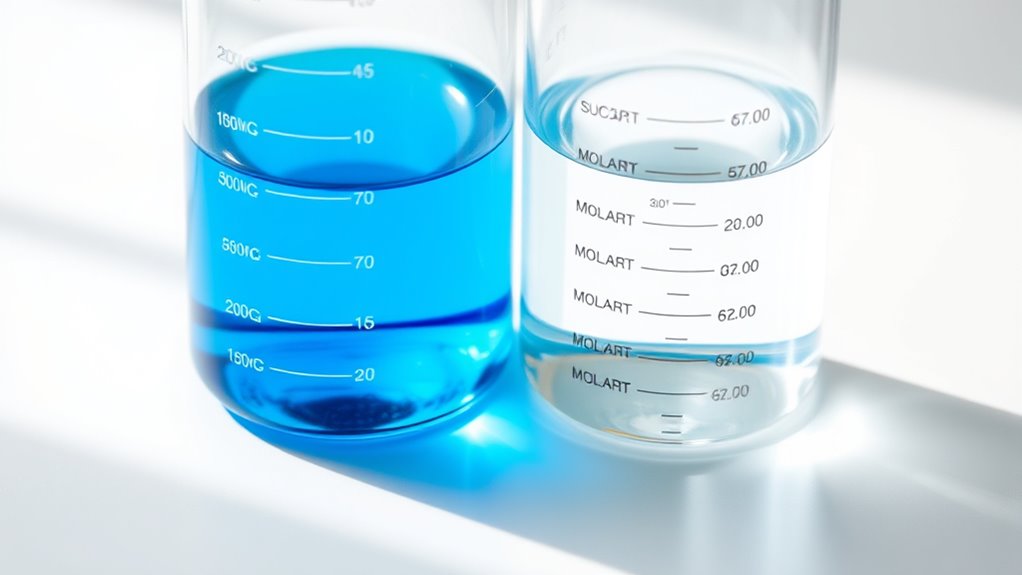
Selecting the appropriate concentration measurement method depends on your experimental conditions. Use molarity when your solution volume is measured accurately with volumetric glassware, especially under stable temperature and pressure. This method is common in clinical labs and biological applications.
However, if temperature or pressure fluctuate, molality offers more reliable results because it depends on mass, which remains constant. For highly concentrated solutions or those with significant volume changes due to solute addition, molality provides better accuracy.
When solutions involve volatile solvents or non-aqueous media, molality minimizes errors caused by volume variations. Consider your measurement tools—balances favor molality, while volumetric equipment favors molarity.
Ultimately, choose the method that aligns with your experimental stability, precision needs, and the nature of your solvents and solutions.
Frequently Asked Questions
How Does Temperature Affect Molarity and Molality Measurements?
You might wonder how temperature impacts your concentration measurements. When temperature rises, solution volume expands, causing molarity to decrease because it depends on volume.
Molality, however, stays the same since it relies on the mass of solvent, which doesn’t change with temperature.
Can Molarity and Molality Be Converted Directly? Why or Why Not?
You’re asking if molarity and molality can be converted directly. They can’t because they rely on different measurements—molarity uses volume, which varies with temperature, while molality depends on solvent mass, which stays constant.
To convert between them, you need extra data like solution density and molar mass, making a direct conversion impossible without these intermediate steps. You must perform calculations to relate volume to mass accurately.
Which Method Provides More Accurate Results for Non-Aqueous Solvents?
Imagine you’re preparing a solution in an organic lab. You’d prefer molality because it’s more accurate in non-aqueous solvents, where volume varies with temperature and pressure.
Molality depends on solvent mass, which stays constant, unlike molarity, affected by volume changes. This stability makes molality the better choice for precise measurements, research, and industrial processes involving non-aqueous solvents.
Using molality ensures consistent and reliable results in these conditions.
How Do Measurement Errors Impact Concentration Calculations Differently?
You want to know how measurement errors affect concentration calculations differently. When measuring molarity, errors in volume measurement and calibration profoundly impact your results because molarity depends on solution volume.
For molality, errors in weighing the solvent matter more since it relies on mass. Larger sample sizes can reduce relative errors in molality, but systematic volume errors greatly influence molarity, especially with small volumes or temperature changes.
When Should I Prefer Molality Over Molarity in Experiments?
Did you know that using molality can improve experiment accuracy by up to 50%? You should prefer molality when your experiments involve temperature fluctuations or require precise control over solvent mass.
Unlike molarity, molality remains constant with temperature changes, making it ideal for studying colligative properties or high-concentration solutions. This guarantees your results stay consistent, especially when thermal conditions vary or accurate solvent measurement is vital.
Conclusion
As you explore molarity and molality, you’ll notice how their differences shape your measurements, like two paths diverging in a lush forest. One guides you by volume, the other by weight—each with its own clarity and purpose. Choosing the right method depends on your journey’s needs. Remember, understanding these nuances helps you navigate chemistry’s landscape with confidence, much like finding your way through a maze of trees into a clear, open clearing.
